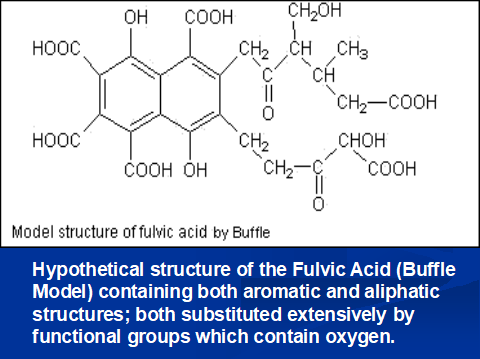About Trace Minerals
There are always difficulties when trying to simplify an explanation of such a complicated molecule. We simplify it as best as possible here, however, for a more in depth explanation, you can view some article links at the bottom of this page.
The first step is to separate the Montmorillonite (Alumin-silicate) portion of it, which is the carrier, to the chelating agent of the Trace Minerals. The chelating agent is called Fulvic Acid.
The Montmorillonite is a clay, a sandwhich, of a double layer of Aluminum and Silica.
Montmorillonite

Inside that sandwich, there is a negatively charged area which attracts positively charged particles.
Among the many positively charged elements that get trapped in this negatively charged area is the Fulvic Acid. This amounts to approximately 10% of this natural product.
Fulvic Acid

This Fulvic Acid, as you can see, is rich in OH radicals, which inter-exchange with heavy metals, chelating them and rendering them atoxic, or non-toxic, and absorbable when needed.
Other positively charged molecules are poisons, venoms, aflatoxins, and other toxins, which get trapped in the Montmorillonite’s inner space and gets eliminated in the feces. This effect is what is known as Cleansing. This is typical of all layered Alumino- Silicates.
Some minerals, such as Arsenic (which is Anionic) are also trapped inside the negatively charged area inside the montmorillonite. It is never absorbed by the Fulvic Acid. It remains inside the Montmorillonite molecule until the Alumino-Silicate leaves the body, expelled in the feces.
The Trace Minerals are chelated into the Fulvic Acid. Therefore, they are not toxic and readily available for the body to absorb. This happens when the mucosae, the last portion of the small intestine, so requires via electromagnetic differential.
What is not utilized in the enzymatic production in the body, is eliminated in the stool. It does not remain in the body and is never deposited into the body tissues.
This enzymatic formation is the principal element in the production of the Metalo-Proteins responsible for the increase in the production of the Mesodermal Cells, particularly in the production of new skin, hair, nail (hoof), scar tissue, cartilage and bone. All of the Trace Minerals are involved; not just the few that the government has quantified and recommends in the food labeling.
Check out our articles...
© 2018 – 2023 AnimalTraceMinerals.com All Rights Reserved